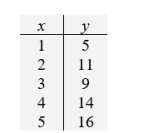Short Answer
Consider the following data.


A) Calculate the least squares estimate .

B) Calculate the least squares estimate .

C) Estimate the error variance .

D) Test H0: 1 = 0 versus H1: 1 0 with = 0.05. Answer "H0 is rejected at = 0.05" or "H0 is not rejected at = 0.05".
E) Estimate the expected y value corresponding to x = 3.
F) Give a 90% confidence interval for the expected y value at x = 3. Round your answer to two decimal places.
Correct Answer:

Verified
Part A: 2.5
Part B: 3.5
Part C...View Answer
Unlock this answer now
Get Access to more Verified Answers free of charge
Correct Answer:
Verified
Part B: 3.5
Part C...
View Answer
Unlock this answer now
Get Access to more Verified Answers free of charge
Q17: Which of the following statements is
Q18: Consider the line y = -6 +
Q19: Consider the data set<br> <br> <img
Q20: Consider the following data set.<br> <img
Q21: Suppose that n = 21,
Q23: An internet site lists the prices, y,
Q24: One measure of the development of
Q25: Calculate the correlation coefficient between the number
Q26: An advertising company collected data on
Q27: Consider the following data set<br> <img src="https://d2lvgg3v3hfg70.cloudfront.net/TB10841/.jpg"